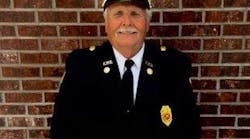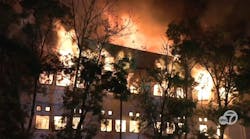Early in the movie The Guardian, the sensational chronicle of elite U.S. Coast Guard rescue swimmers, Sr. Chief Ben Randall, played by Kevin Costner, delivers a powerful line: “There’s a gap between training and what really happens out there. I intend to change that.”
Over the past year, I’ve studied methodologies for training occupational athletes founded on that same principle (although with less charm than Kevin Costner). By developing basic movement guidelines that tie directly to the professional work required for firefighting, we can simplify the complex world of “functional fitness.” Moreover, we can better connect the fitness setting to “what really happens out there.”
Fireground-Specific Fitness
With more than half of all firefighter deaths and more than half of all injuries occurring from causes unrelated to fire, new approaches to fitness training are the most valuable investment we can make in our firefighters today.
Through program experimentation and basic pedagogy, my team has identified a rubric for translating controlled fitness settings to the professional performance arena—in our case, the fireground. These principles provide a foundation on which to design specific exercises related to job skills. Here’s a peek at the architecture.
STEP 1: Break Down the Work
We must first break down our work into bite-sized pieces. This means defining maneuverable areas that represent 100 percent of the required movements on the fireground. ( Note: The choice of eight areas was not prescriptive here.)
Gear Operations
Donning, wearing, hauling, loading and managing equipment—both personal and professional—requires us to constantly shift the weight of our load on our bodies. Gear management in and of itself demands endurance and stability before we even get to work on the fire.
Forcible Entry (FE)
We need efficient access to fire and victims. FE equipment weighs up to 10 lbs. per piece and requires back, shoulder, forearm, grip and core muscle strength to operate properly and prevent strain. This means building from the inside out, preparing seldom-used muscles for high-pressure requirements.
Ventilation
Breaching, chopping and overhaul work demands repetitive movement—hammering, pushing, pulling, etc., over and over again. Muscles need both power and endurance to successfully accomplish this work and still have something left for their next test. Both technique and strength have equal importance here.
Ladders
Tools help us gain access, bring team members to safety and execute contingency planning. Working with ladders must be swift and steady. We must prepare for the ability to climb into and out of dangerous environments while hauling and operating tools.
Search Operations
Search teams locate fire and victims. One hundred percent of this work requires us to stay low to the ground while our vision is often completely blacked out. Movements required for sweeping buildings in search maneuvers are demanding and unnatural. (After all, when is the last time you hung out comfortably on all fours? Right around the time you learned to talk.)
Hose Handling
Charged fire hose is heavy and unwieldy. Advancing hose means climbing, pulling, weaving, dragging and repositioning 100-lb. coils. We can only generate the power and stability while executing these maneuvers if we prepare the body for working with weight and resistance while off balance.
Rescue Operations
Rescue teams save lives. The stamina and strength of rescuers, therefore, separate life from death for victims being transported down a flight of stairs or out a window. The right type of quad, core and grip strength can quickly turn failure into success.
Cardio Burst
When the alarm sounds, trucks need to move within minutes. We are roused from sleep, rest, sitting, eating and any other activity and forced to instantly exert short, powerful bursts of energy to don gear, jump rigs and respond.
Armed with these eight maneuver categories, we can consider the fundamentals that connect them, leading us to the next step in fitness program design.
STEP 2: Develop Movement Guidelines
Next, we must develop simple movement guidelines that transcend across each maneuver category. The resulting principles govern all exercises that we develop for a specific occupation. Three movement principles fall naturally out of the above fire ground requirements:
1. LowMotion - Everything we do on the fireground happens “on the down-low,” so to speak. The principle of LowMotion, or performing exercises in a crouched or squat position, should be pervasive across your circuit training, even in upright exercises. Knees should be kept bent, and the body should be kept in a low and stable position, spending as much time on all fours as possible.
2. Burst of Power - Most of what we do on the fireground, as described in our eight maneuver areas in Step 1, requires short bursts of power. Circuit exercises should force participants to generate these bursts in intervals that range from 10 seconds to 2 minutes.
3. Weight Load Imbalance - No matter how hard we try, weight will never be evenly loaded when we’re working on the fireground. Therefore, workouts should load our bodies with weight in imbalanced positions. Start with 5—10 lbs. and then gradually increase the weight as your physical strain decreases. upward. This is critical to maintain safety and build strength.
STEP 3: Design Circuit Programs
Lastly, design circuit programs based on these eight maneuver areas and three movement principles. To give your program a jumpstart, here are a few sample circuit exercises.
Cyclones
Cyclones are movements that involve combinations of squatting, twisting, and lifting weight on diagonal planes. Shown is a basic cyclone dropping into a squat with weight on one side of the body. The weight is lifted across the body and upward. (Fireground skills: Gear Operations, Forcible Entry, Ventilation.)
Suicide Sprints
These are performed as a burst of forward movement, with weight tucked under one side of the body. The best practice is to start out by sprinting 30 yards with a lighter weight (10 lbs.), and then drop it. Then sprint 20 yards with a mid-level weight (15 lbs.), then 10 yards with a heavy weight (20 lbs.). Then return with speed bursts to pick up weights. (Fireground skills: Hose Handling, Cardio Burst, Ventilation.)
Box Obstacles
A box obstacle is simply a mini-obstacle course of boxes and steps to navigate. Loaded with weight on one shoulder, these motions train us for multi-faceted fireground environments. (Fireground skills: Gear Operations, Ladders, Rescue Operations.)
Kodiaks
Kodiaks are LowMotion movements that help properly train firefighters on required maneuvers. Standard bear crawls, if executed without imbalanced weight and obstacles, do not mimic what really happens out there. The best practice is to hold weight in one hand, using a multi-lateral motion pattern, and then navigate the obstacles across 20–50 yards. (Fireground skills: Search Operations, Gear Operations, Rescue Operations.)
Tire Slams
No need for giant tires if you don’t have them. Small tires or even a wooden block with weight on top works for this workout. Practicing the proper technique for power bursts with tools to avoid musculoskeletal strain is the key objective. (Fireground skills: Gear Operations, Forcible Entry.)
A Final Word
We can generate thousands of movements to mimic the fireground in a safe and controlled fitness setting, without pulling out trucks, hooking hydrants or dragging tools off rigs. Here, we’ve just scratched the surface of other, equally challenging alternatives!
SARAH APGAR is an Iraq War veteran and a firefighter and EMT with the Halesite, NY, Fire Department. She is director of the Halesite Firefighter Fitness Training Program and an ACE-certified fitness trainer. She has a bachelor’s degree from Princeton University and received her MBA from Dartmouth College. Sarah can be reached at [email protected].






